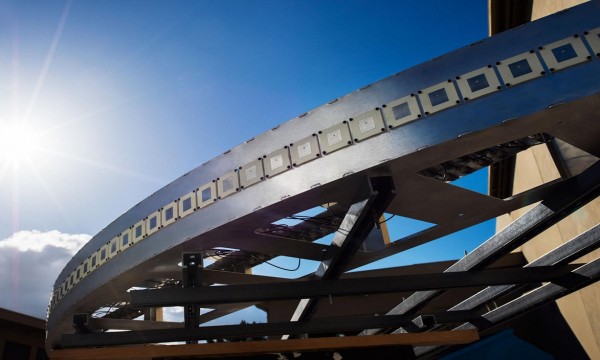By Steve Pak, | April 14, 2016

Terragraph and ARIES Antennas
Facebook's F8 developer conference has already included a 360-degree video camera and the social network just unveiled an array of wireless antennas to provide Internet access. The social network's new antennas can deliver web access to mobile devices in rural areas that are dozens of miles away from big cities. Mark Zuckerberg's company claims the Internet technology known as Antenna Radio Integration for Efficiency in Spectrum (ARIES) set a world record for efficiency and could be used in developing countries in Africa and Asia.
Like Us on Facebook
The colossal antennas can be installed in well-wired urban areas then wirelessly beam Internet access to surrounding rural regions. Facebook's vice president of infrastructure Jay Parikh explains that the wireless transmission method is much cheaper than installing fiber optics and power lines in the rural areas, and using old-school antenna systems. Google is inventing a new type of base station.
ARIES is one type of complex hardware Facebook is building to expand Internet access. At F8 2016 the social giant also introduced a wireless antenna system known as Terragraph that boosts cellular and Wi-Fi signals within cities, according to Wired. The company is also developing flying drones that can beam Internet access to remote rural areas.
Terragraph transmits a high-bandwidth signal in urban areas without requiring a lot of high-cost fiber lines between the antennas. The reason is that antennas communicate wirelessly with other units with a 60 gigahertz spectrum, which ends the need for fiber.
Other tech giants are also working on new tech to expand Internet access. Google is building drones and balloons to beam the Internet from the Earth's stratosphere. Meanwhile, hardware manufacturers are also working on next-gen wireless antennas.
In other F8 news, Facebook unveiled a 360-degree video camera at the developer conference on April 12, Tuesday. The open-source device called Surround 360 is shaped like a flying saucer and uses a 17-camera array and web-based software to automatically render 360 video, according to The Verge.
Facebook claims the new camera solves many problems related to 360-degree video. The unit includes 14 wide-angle cameras and three fish-eye cameras. A demo showed clear video captured by Surround 360 but it appeared a little grainy when viewed on Samsung Gear VR.
Here's Facebook's Surround 360 camera:
-
Use of Coronavirus Pandemic Drones Raises Privacy Concerns: Drones Spread Fear, Local Officials Say

-
Coronavirus Hampers The Delivery Of Lockheed Martin F-35 Stealth Fighters For 2020

-
Instagram Speeds Up Plans to Add Account Memorialization Feature Due to COVID-19 Deaths

-
NASA: Perseverance Plans to Bring 'Mars Rock' to Earth in 2031

-
600 Dead And 3,000 In The Hospital as Iranians Believed Drinking High-Concentrations of Alcohol Can Cure The Coronavirus

-
600 Dead And 3,000 In The Hospital as Iranians Believed Drinking High-Concentrations of Alcohol Can Cure The Coronavirus

-
COVID-19: Doctors, Nurses Use Virtual Reality to Learn New Skills in Treating Coronavirus Patients











